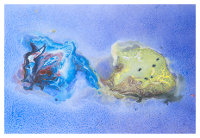Conveners
Parallel II: B1 Light Quarks
- Hagop Sazdjian (University Paris-Sud)
Dr
Jeremy Green
(Institut für Kernphysik, Johannes Gutenberg-Universität Mainz)
08/09/2014, 14:00
Section B: Light Quarks
Recent progress in lattice QCD calculations of hadron structure will
be presented, with an emphasis on nucleon structure. Calculations of
nucleon form factors have long been difficult to reconcile with
experiment, but with advances in both methodology and computing
resources, this situation is changing. Agreement with experiment is
beginning to be obtained for several key observables, and...
Dr
Alexey Vladimirov
(Lund University)
08/09/2014, 14:30
Section B: Light Quarks
We present the method of calculation of leading logarithms for the nucleon sector of chiral perturbation theory in heavy baryon formulation and in the relativistic invariant formulation. We have studied the leading logarithm behavior of the nucleon mass up and present the expression for it up to four-loop order exactly. We also present some results up to six-loop order as well as all-order...
Miha Mihovilovic
(Johannes Gutenberg-Universitaet Mainz)
08/09/2014, 14:50
Section B: Light Quarks
The discrepancy between the proton charge radius extracted
from the muonic hydrogen Lamb shift measurement and the best present
value obtained from the elastic scattering experiments, remains
unexplained and represents a burning problem of today's nuclear physics.
After more than 50 years of research the radius of a basic
constituent of matter is still not understood.
This...
Clara Peset
(Universitat Autonoma de Barcelona /IFAE)
08/09/2014, 15:20
Section B: Light Quarks
We obtain a model independent expression for the muonic hydrogen Lamb shift. The leading hadronic effects are controlled by the chiral theory, which allows for their model independent
determination. We give their complete expression including the pion and Delta particles. Out of this analysis and the experimental measurement of the muonic hydrogen Lamb shift we determine the electromagnetic...
Jose R. Pelaez
(Universidad COmplutense)
08/09/2014, 15:40
Section B: Light Quarks
We study the large Nc behavior of couplings among light meson states with
different compositions in terms of quarks and gluons. We shortly review the
most common compositions of mesons, which are of interest for the
understanding of low-lying meson resonances, namely, the ordinary
quark-antiquark states as well as the non-ordinary, glueball, tetraquark,
etc. We dedicate special attention...
